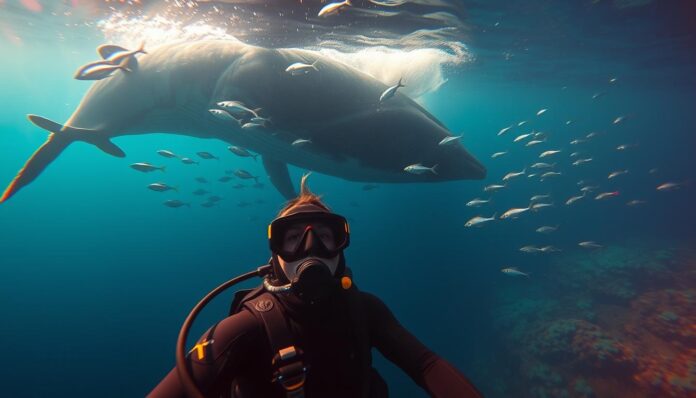Imagine diving with a marine giant so rare, only two places in the world allow it. Dominica is one of them, giving scuba divers a chance to dive with sperm whales. This adventure draws people from all over the world.
Only a few boats can get close to these amazing creatures. This makes the experience truly special.
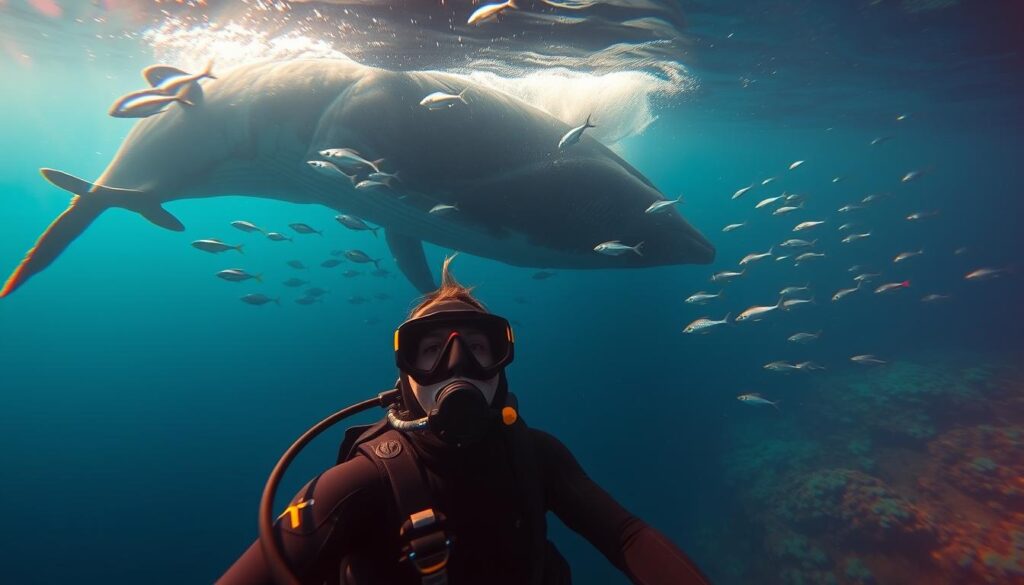
In Dominica, whale watching becomes more than just looking. You can swim with female sperm whales and their young. This happens from November to March, when they rest after deep dives.
Professional guides use special technology to find these whales. They make sure we meet them in a way that’s good for both us and the whales. The underwater world in Dominica is full of life, making it perfect for exploring and meeting whales.
Key Takeaways – Diving with Sperm Whales
- Dominica offers exclusive sperm whale diving experiences
- Limited permits ensure sustainable marine interactions
- Peak season runs from November to March
- Advanced hydrophone technology aids whale tracking
- Encounters focus on female whale groups
- Trips range from 7-8 days with multiple whale encounter opportunities
Introduction to Sperm Whales
Exploring the open ocean reveals the amazing world of sperm whales. They are the most incredible marine mammals on Earth. These creatures are nature’s top predators, fascinating both underwater photographers and marine researchers.
What are Sperm Whales?
Sperm whales are truly remarkable marine mammals known as Physeter macrocephalus. They are the largest predators on Earth. They have amazing physical features:
- Length: Up to 70 feet (21 meters)
- Weight: Up to 80 tonnes
- Brain size: Largest of any creature, weighing up to 20 pounds
Why Dive with Sperm Whales?
Diving with sperm whales is an unmatched underwater photography experience. These giants have incredible abilities that make encounters unforgettable:
| Diving Capability | Details |
|---|---|
| Maximum Depth | 3,280 feet |
| Breath-Holding | Up to 90 minutes |
| Swimming Speed | 3-20 miles per hour |
“To encounter a sperm whale is to witness the true majesty of marine life in its most raw and powerful form.” – Marine Biologist
These incredible creatures offer divers a unique chance to explore the deep. Every underwater expedition with them is an unforgettable adventure in open ocean exploration.
The Best Locations for Scuba Diving
Exploring the world’s most remarkable destinations for sperm whale encounters requires careful planning. It also needs a passion for marine conservation efforts. Sustainable tourism is key in creating meaningful experiences while protecting these magnificent marine mammals.
Diving with sperm whales offers an extraordinary adventure across several global hotspots. Each destination presents unique opportunities for marine enthusiasts. They seek close encounters with these incredible creatures.
Top Destinations Worldwide
- Asia:
- Sri Lanka: The warm waters off the southern coast of Sri Lanka are a popular spot for encountering Sperm Whales. The season typically runs from November to April when these gentle giants migrate closer to the island.
- Azores, Portugal: Located in the North Atlantic Ocean, the Azores archipelago is renowned for its resident population of Sperm Whales. Divers can experience close encounters with these incredible creatures year-round.
- Africa:
- Dominica: Known as the “Whale Watching Capital of the Caribbean,” Dominica offers excellent opportunities for diving with Sperm Whales. The nutrient-rich waters surrounding the island attract these magnificent creatures, particularly between November and March.
- Mozambique: The warm waters of Mozambique are home to a diverse marine ecosystem, including Sperm Whales. Divers can encounter them along the coastline, particularly in areas like Pemba and Tofo.
- Caribbean:
- Silver Bank, Dominican Republic: The Silver Bank, located in the Atlantic Ocean between the Dominican Republic and the Turks and Caicos Islands, is a popular breeding and calving ground for Humpback Whales. While diving in this area, there is a chance of encountering Sperm Whales as well.
- Dominica: As mentioned earlier, Dominica is a prime destination for diving with Sperm Whales in the Caribbean. Its commitment to marine conservation and responsible whale watching practices make it an ideal location for encounters with these incredible creatures.
- Central America:
- Costa Rica: The Pacific coast of Costa Rica, particularly the Marino Ballena National Park, is known for its rich marine biodiversity. While diving in this area, divers may have the opportunity to encounter Sperm Whales alongside other marine species such as dolphins and sea turtles.
- Europe:
- Azores, Portugal: The Azores archipelago, situated in the North Atlantic Ocean, is not only a renowned destination for encountering Sperm Whales but also a hotspot for various whale and dolphin species. The islands provide excellent opportunities for divers to witness these marine mammals in their natural habitat.
- Oceania:
- Kaikoura, New Zealand: The coastal town of Kaikoura is famous for its abundant marine life, including Sperm Whales. The deep underwater canyons near the coast attract these majestic creatures, offering divers a chance to observe them up close.
- North America:
- The Great Barrier Reef, Australia: The Great Barrier Reef is not only known for its stunning coral formations but also for its diverse marine life. Sperm Whales are occasionally spotted in the waters surrounding the reef, making it an excellent destination for encountering these creatures.
- South America:
- Peninsula Valdes, Argentina: Located in the Patagonia region of Argentina, the Peninsula Valdes is a UNESCO World Heritage Site known for its diverse marine wildlife. Sperm Whales can be encountered here, alongside other marine species such as sea lions and orcas.
Please note that the timing and frequency of Sperm Whale encounters may vary within these regions. It is essential to check with local dive operators or experienced guides who have knowledge of the area and the migratory patterns of these marine mammals.
Embarking on a diving adventure to one of these destinations provides a unique opportunity to witness the majesty of Sperm Whales and explore the rich marine ecosystems they inhabit. Remember to prioritize responsible diving practices and respect for the marine environment to ensure the well-being of these incredible creatures and the preservation of their habitats.
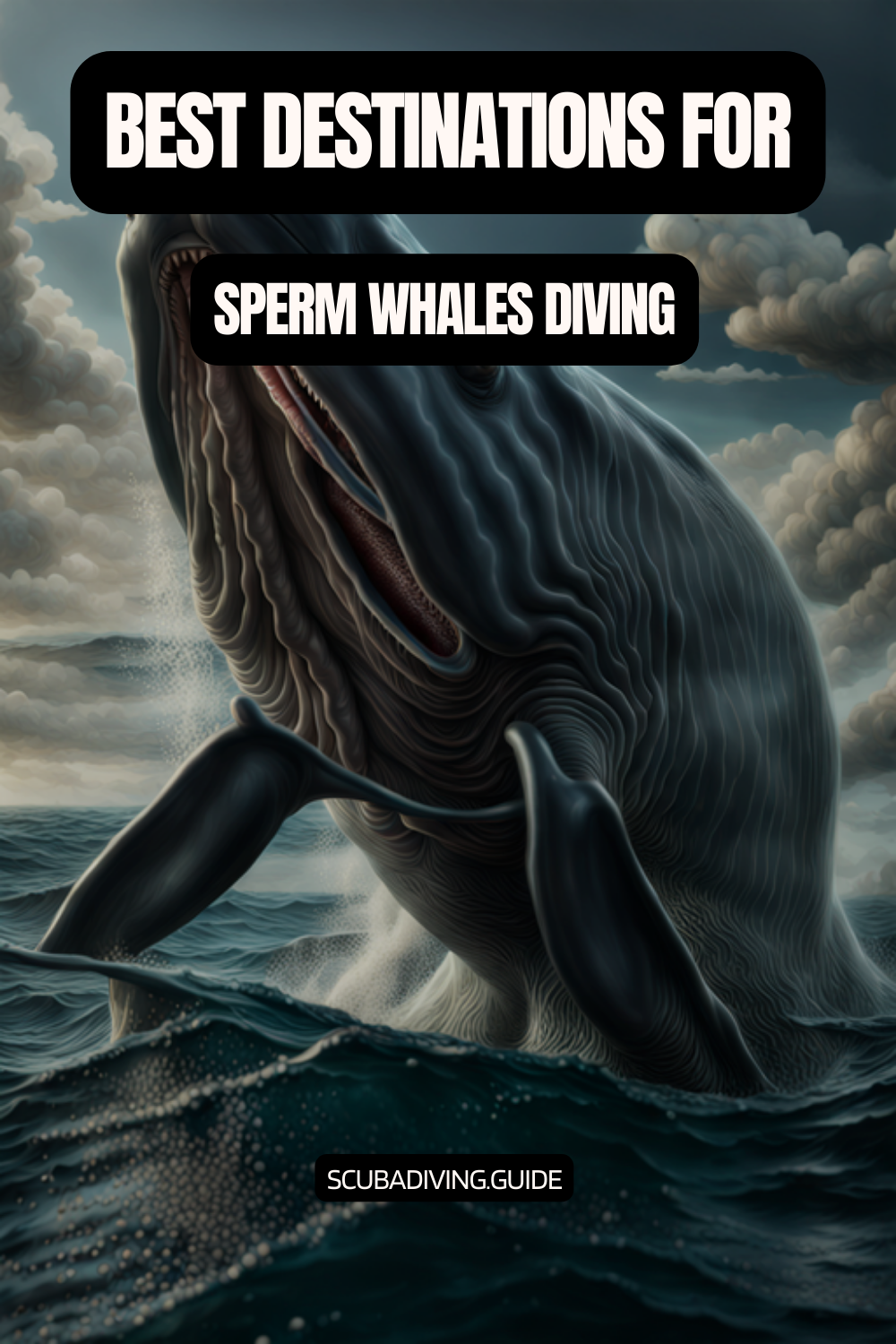
Seasonal Best Times for Whale Encounters
| Location | Best Months | Estimated Cost per Person |
|---|---|---|
| Dominica | November – March | $5,500 + Airfare |
| Azores | April – October | $4,500 – $6,000 |
| Silver Banks | January – April | $4,500 (Excluding Airfare) |
When planning your sperm whale diving expedition, consider the conservation efforts of each destination. Responsible operators prioritize marine protection. They ensure minimal disturbance to these incredible marine ecosystems.
“Diving with sperm whales is not just an adventure, it’s a privilege and a responsibility to protect our ocean’s most magnificent inhabitants.”
Remember that each location requires specific permits and strict guidelines. These are to protect both divers and whales. Research licensed operators who show commitment to marine conservation and sustainable tourism practices.
Preparation for Your Dive
Snorkeling with whales needs careful planning and a focus on respecting whales. The world of sperm whales is magical but requires respect and knowledge. You’ll also need the right gear for a safe and unforgettable dive.
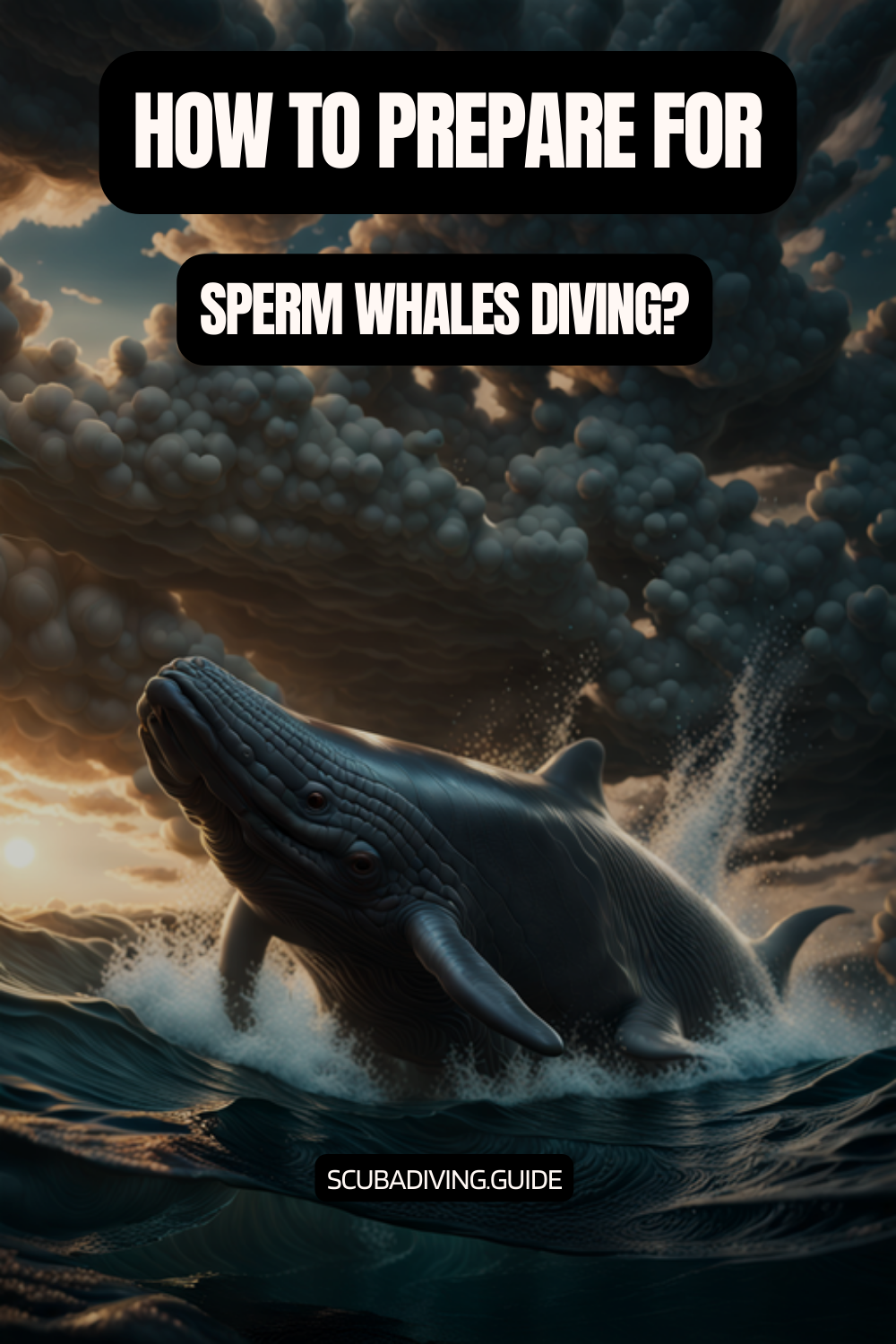
Essential Gear for Diving
For a safe dive, you need specific equipment. Experts suggest the following:
- High-quality wetsuit for deep water
- Advanced underwater breathing apparatus
- Specialized underwater communication devices
- Underwater camera for documenting
- Protective diving mask with wide vision
Health and Safety Considerations
Being physically fit is key for whale encounters. Divers must pass medical checks and stay in top shape. Sperm whales dive as deep as 1000 meters, so you need to be in great physical condition.
“Preparation is the key to transforming a risky whale encounter into an extraordinary experience.” – Marine Biology Research Team
Pre-Dive Briefings
Responsible whale interactions start with detailed pre-dive briefings. These cover important topics like:
- Whale behavior and communication
- Safe approach techniques
- Ecological sensitivity protocols
- Emergency response strategies
Pro tip: Look into specialized training for marine mammal interactions. It can improve your diving skills and understanding of whale ecosystems.
Understanding Sperm Whale Behavior
Diving into the world of sperm whales shows us a complex social scene. It’s a place where marine life encounters become truly special. These whales have behaviors that amaze both researchers and those who love whales.
Social Structures of Sperm Whales
Sperm whale groups are unique in the sea. They have social structures that are fascinating:
- Female sperm whales form tight-knit family units called pods
- Mature males typically travel separately from female groups
- Juveniles remain close to maternal groups for extended periods
Communication Among Sperm Whales
Sperm whales talk to each other in special ways. They use sound to show their smart social skills. Studies have shown how they communicate:
| Communication Method | Purpose | Frequency |
|---|---|---|
| Echolocation | Navigation and Prey Detection | Constant During Foraging |
| Vocalization Clicks | Social Interaction | Multiple Times per Hour |
| Deep Dive Signals | Group Coordination | Before Extended Foraging |
“Sperm whales are not just marine mammals, they are complex social beings with intricately complex communication networks.” – Marine Behavioral Research Institute
Sperm whales dive a lot, about 42.6 times a day. Most of these dives are for finding food. They can dive really deep, over 1,000 meters, and stay down for more than an hour.
Knowing how sperm whales behave is key. It helps us have better interactions with them. And it helps us make sure our whale watching is respectful and ethical.
The Dive Experience
For those who love underwater photography and exploring the open ocean, diving with sperm whales is a unique adventure. It gives a rare look into the secret world of these huge sea creatures.
To meet sperm whales, you need patience and the right spot. Divers often wait for hours in the vast blue sea, hoping for that special moment.
What to Expect Underwater
- Depths ranging from 3,000 to 6,000 feet
- Surface intervals between 5-10 minutes
- Potential encounters with multiple whale species
Encountering Sperm Whales Up Close
Meeting sperm whales can be unpredictable. Our recent trip from March 31 to April 7, 2024, showed us:
| Marine Life Encounters | Details |
|---|---|
| Whale Sightings | 1 day out of 6 (April 3) |
| Whale Observations | 10-12 different whales sighted |
| Dolphin Species | 2 species observed |
Capturing the Moment: Photography Tips
Underwater photography needs special skills and gear. Here are some tips:
- Use wide-angle lenses for big ocean views
- Keep a safe distance from sea creatures
- Adjust camera settings for dark places
“The ocean is a lens through which we glimpse the extraordinary world of sperm whales.” – Marine Photographer
Exploring the open ocean requires preparation, respect for the sea, and a sense of adventure. Every dive is different, with its own challenges and chances to see marine life up close.
Environmental Considerations
Diving with sperm whales is a unique chance to connect with marine life. It also supports important conservation efforts. These amazing creatures are key to ocean ecosystems, showing how delicate marine life is.
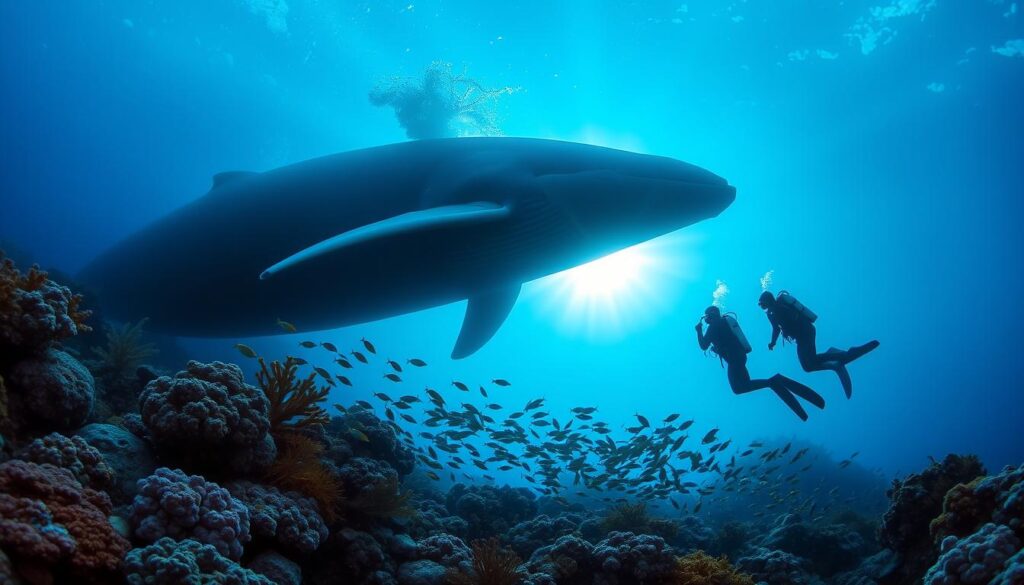
The Importance of Marine Conservation
Sperm whales are vital to our oceans. They remove about 240,000 tons of carbon from the air each year. Their role in nutrient cycling is incredible, supporting marine life in many ways.
- A single whale fall event can sustain over 400 deep ocean species for a decade
- Sperm whale populations have grown approximately 4% annually
- Sustainable tourism supports marine conservation efforts
Responsible Diving Guidelines
Sustainable tourism means being careful with marine environments. Divers can help by following these guidelines:
- Keep a safe distance from marine wildlife
- Choose eco-friendly diving gear
- Reduce underwater noise and disturbance
- Support local marine conservation programs
“Every dive is an opportunity to become a steward of the ocean’s delicate ecosystems.”
Knowing how marine species are connected helps us in conservation. Sperm whales, with their complex social lives and important roles, show us how marine life is connected.
| Conservation Metric | Impact |
|---|---|
| Carbon Removal | 240,000 tons annually |
| Population Growth Rate | 4% per year |
| Ecological Support | 400+ deep ocean species sustained |
By diving responsibly, we can make our underwater adventures help marine conservation and sustainable tourism.
Regulations and Guidelines
Responsible whale interactions need strict rules and guidelines. Ethical whale tourism means planning carefully and knowing the law before diving with these amazing sea creatures.
Permits Required for Diving
To dive with sperm whales, you need special permits from the government. Dominica, a top spot for whale watching, requires certain documents for swimmers and tour operators.
- Get a whale swim permit from the government
- Check if the whale encounter operator is licensed
- Follow local marine conservation laws
Safety Protocols to Follow
Keeping a safe distance and respecting their homes is key for safe whale interactions. Tour operators have strict rules to protect both divers and the sea creatures.
| Safety Protocol | Specific Requirements |
|---|---|
| Group Size Limitation | Maximum 3 people per whale encounter |
| Interaction Duration | 15 seconds to 1 hour |
| Distance Maintenance | Minimum recommended distance of 10 meters |
“Respect for marine life is the foundation of ethical whale tourism.”
Divers need to know these rules protect both humans and the sperm whales. By following these guidelines, we help conservation and make sure our sea interactions are safe and sustainable.
Training and Certification
To dive with Sperm Whales, you need special training and a full certification. It’s important to know how to dive safely and respect the ocean. This way, you can enjoy the marine life without harming it.
Getting Certified for Deep Diving
Scuba diving with sperm whales needs advanced skills. You must learn:
- Advanced Open Water Certification
- Deep Diving Specialization
- Underwater Navigation
- Emergency Management
“Proper training transforms an ordinary dive into an extraordinary marine life experience.”
Recommended Courses for Whale Diving
There are special courses for diving with whales. They help you learn how to interact with marine life safely. Some top courses are:
- PADI Marine Ecology Course
- Advanced Deep Diving Certification
- Marine Mammal Observer Training
- Underwater Photography Specialization
These courses teach you how to dive responsibly. You’ll learn to explore the ocean safely and with care. This way, you can enjoy diving with Sperm Whales while protecting the sea.
Stories from Divers
Whale watching and snorkeling with whales are among the most unforgettable marine experiences. Divers who dive deep often come back with amazing stories. These stories change how they see marine life.
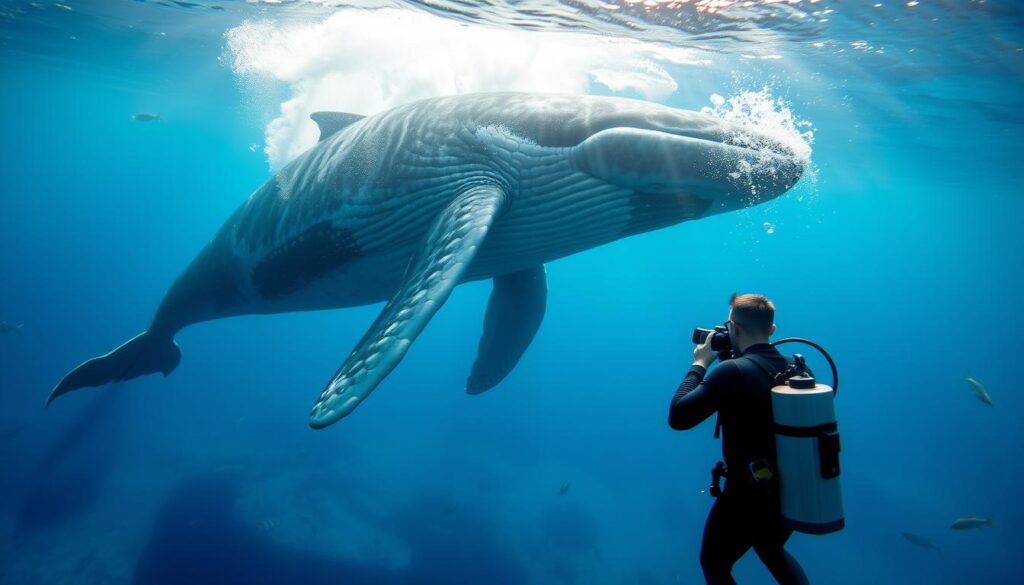
Memorable Encounters with Sperm Whales
A marine researcher formed a special bond with a sperm whale named Scar off Dominica’s coast. Ten years ago, Scar showed up with serious injuries. Yet, the whale showed incredible strength.
“The connection with marine life goes beyond observation. It’s about mutual respect and understanding.” – Marine Researcher
Lessons Learned Underwater
Divers learn important lessons about marine conservation and animal behavior through whale watching. Key insights include:
- Sperm whales communicate through complex sound systems
- Interactions require strict permit regulations
- Respect for wild animals is key
- Each whale has a unique personality and story
The research also shared some interesting facts about these creatures:
- Mature male sperm whales can reach up to 67 feet in length
- They can dive as deep as 7,382 feet
- Sperm whales produce sounds up to 230 decibels
Snorkeling with whales is more than an adventure. It’s a life-changing experience that connects us with the ocean’s deep mysteries.
Common Marine Species Found Alongside Sperm Whales
When diving with Sperm Whales, you’ll often encounter a diverse array of marine species that share their habitat. These cohabiting species create a vibrant and interconnected ecosystem, further enriching the diving experience. Let’s explore some of the common marine species found alongside Sperm Whales:
- Giant Squid: The giant squid (Architeuthis) is an iconic creature that captivates the imagination. These elusive cephalopods, known for their immense size, can grow up to 43 feet (13 meters) in length. While direct sightings of giant squids are rare, their presence is often inferred from the scars and marks found on the bodies of Sperm Whales. These marks are believed to be the result of intense battles between the whales and the elusive giant squid during their deep-sea encounters.
- Dolphins: Dolphins are highly social and intelligent creatures that frequently share the same oceanic habitats as Sperm Whales. These playful and acrobatic marine mammals are known to exhibit curious behaviors, often approaching divers with enthusiasm. Swimming alongside a pod of dolphins while diving with Sperm Whales adds an extra layer of joy and excitement to the underwater experience.
- Pilot Whales: Pilot whales, both short-finned (Globicephala macrorhynchus) and long-finned (Globicephala melas), are commonly encountered alongside Sperm Whales. These smaller members of the whale family are highly social and travel in cohesive pods. Witnessing their synchronized movements and observing their close-knit family dynamics is a fascinating sight during a dive.
- Tuna and Billfish: Sperm Whales are known to frequent areas where pelagic fish species, such as tuna and billfish, gather in large numbers. These fast-swimming and highly migratory fish species are often seen darting through the water, creating a dynamic and lively atmosphere. Diving alongside these agile predators provides an opportunity to witness the intricate balance of marine life in action.
- Sea Birds: Above the water’s surface, a variety of sea birds often accompany Sperm Whales. These birds, such as petrels, shearwaters, and gulls, are attracted to the activity and movement in the water, indicating potential feeding opportunities. Observing these graceful birds soaring above the waves while diving with Sperm Whales adds an element of beauty and serenity to the overall experience.
- Various Fish Species: Sperm Whales are often found in areas teeming with fish species that make up their primary diet. These can include various types of squid, such as the colossal squid (Mesonychoteuthis hamiltoni), as well as different species of fish like hake, mackerel, and lanternfish. These smaller fish species contribute to the intricate food web in the ocean and play a crucial role in sustaining the larger marine life.
Encountering these diverse marine species alongside Sperm Whales showcases the interconnectedness and complexity of ocean ecosystems. Each organism contributes to the delicate balance of the underwater world, and witnessing their interactions during a dive enhances our appreciation for the richness and diversity of marine life.
When diving with Sperm Whales, take the time to observe and appreciate these cohabiting species, understanding that their presence is a testament to the health and vitality of the marine environment. Remember to approach all marine life with respect, maintaining a safe distance, and minimizing any disturbances to their natural behaviors.
Conclusion and Final Thoughts
Scuba diving with sperm whales is an amazing experience that goes beyond usual wildlife adventures. It lets you see a part of the ocean that few get to see. These dives take you deep into the ocean, where sperm whales live.
Planning a dive with sperm whales needs careful thought. Places like Dominica offer great chances from November to June. Trips can cost between $7,288 and $7,488. It’s important to choose operators who care about the ocean and don’t disturb the whales.
Planning Your Adventure
When you’re ready to dive with sperm whales, do it responsibly. Learn about their behavior and keep a safe distance. Sperm whales are vulnerable, so we must protect them.
Embracing the Sperm Whale Experience
Your dive with sperm whales will change you. These smart whales use sound to talk to each other from far away. By diving with respect, you can help protect the ocean and grow as a person.
FAQ – Diving with Sperm Whales
Are sperm whales dangerous to divers?
Sperm whales are not usually aggressive towards humans. They are curious and smart, often ignoring divers. It’s important to keep a safe distance and follow professional rules for both diver and whale safety.
What is the best time of year to dive with sperm whales in Dominica?
You can dive with sperm whales in Dominica all year, but the best time is from November to March. This is when the weather is best for seeing whales and diving.
What certifications do I need to dive with sperm whales?
You need an advanced open water certification and deep diving skills. You also need lots of experience with ocean diving. Courses on marine life and whale encounters are recommended for a safe dive.
How close can I get to sperm whales underwater?
You should stay at least 15-20 meters (50-65 feet) away from sperm whales. Getting too close can stress them and disrupt their behavior. Always listen to marine naturalists and local experts.
What equipment do I need for sperm whale diving?
You’ll need good scuba gear, a wetsuit for the ocean, and an underwater camera. You’ll also need a dive computer and special communication devices. Most operators provide extra gear for whale dives.
Are there age or fitness restrictions for diving with sperm whales?
You must be 18 or older and in great shape. You’ll need a medical check and to be able to swim well in the ocean. It’s best if you have lots of diving experience.
How ethical are sperm whale diving experiences?
Good operators focus on marine conservation and follow strict rules. They also help with research and protect whales. Choosing the right tour supports conservation and has little impact on the environment.
What is the average cost of a sperm whale diving expedition?
Prices vary, but expect to pay between $1,500 to $5,000 for a few days. This includes guides, boat, gear, and often educational talks on marine conservation.
Can I take underwater photographs during the dive?
Yes, taking photos is allowed and encouraged. But, remember to focus on whale safety and behavior first. Guides will give you tips on how to take photos responsibly.
What makes Dominica a unique destination for sperm whale encounters?
Dominica has deep canyons that are perfect for sperm whales. The island has protected areas, few boats, and a steady whale population. It’s a top place for safe and ethical whale encounters.
